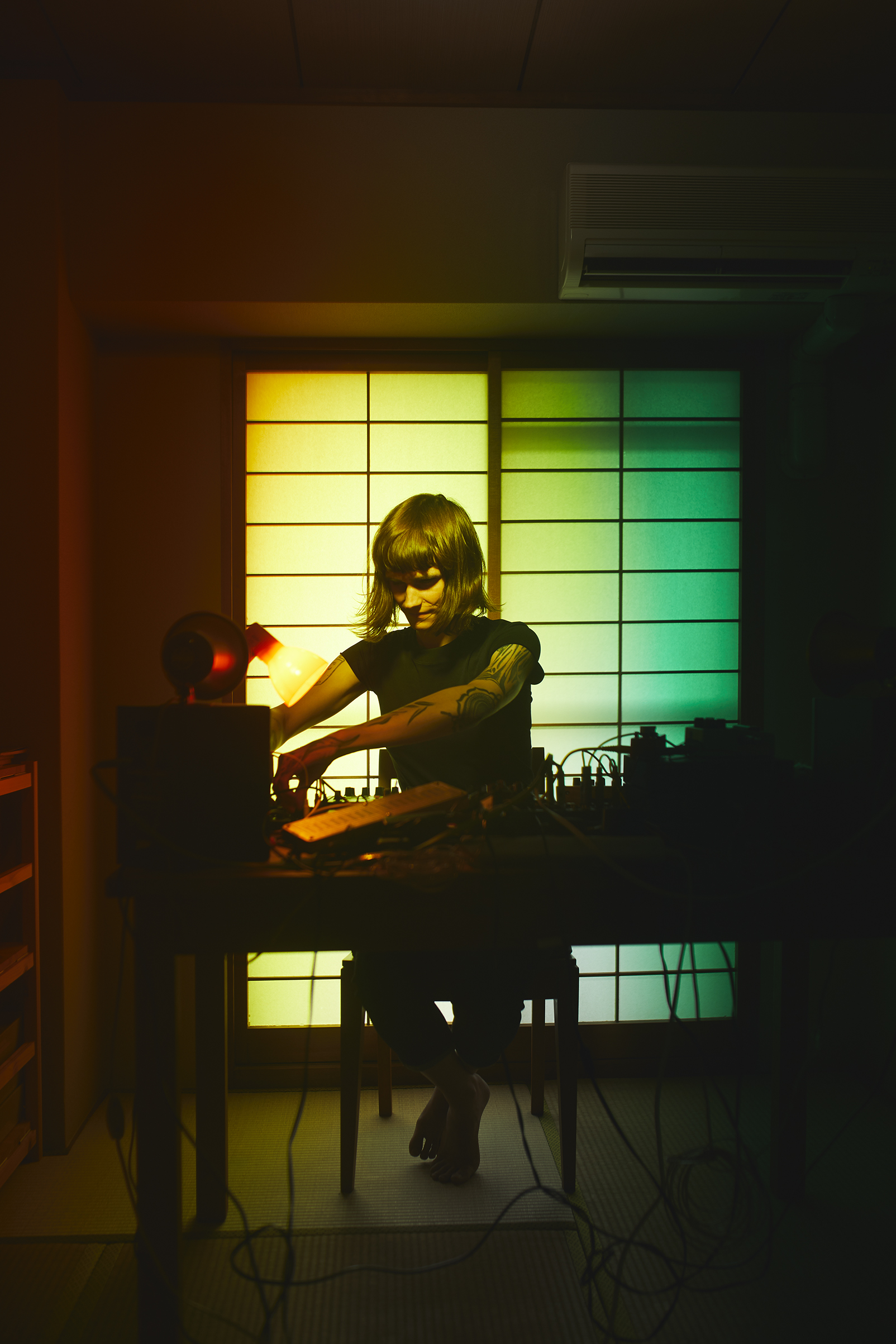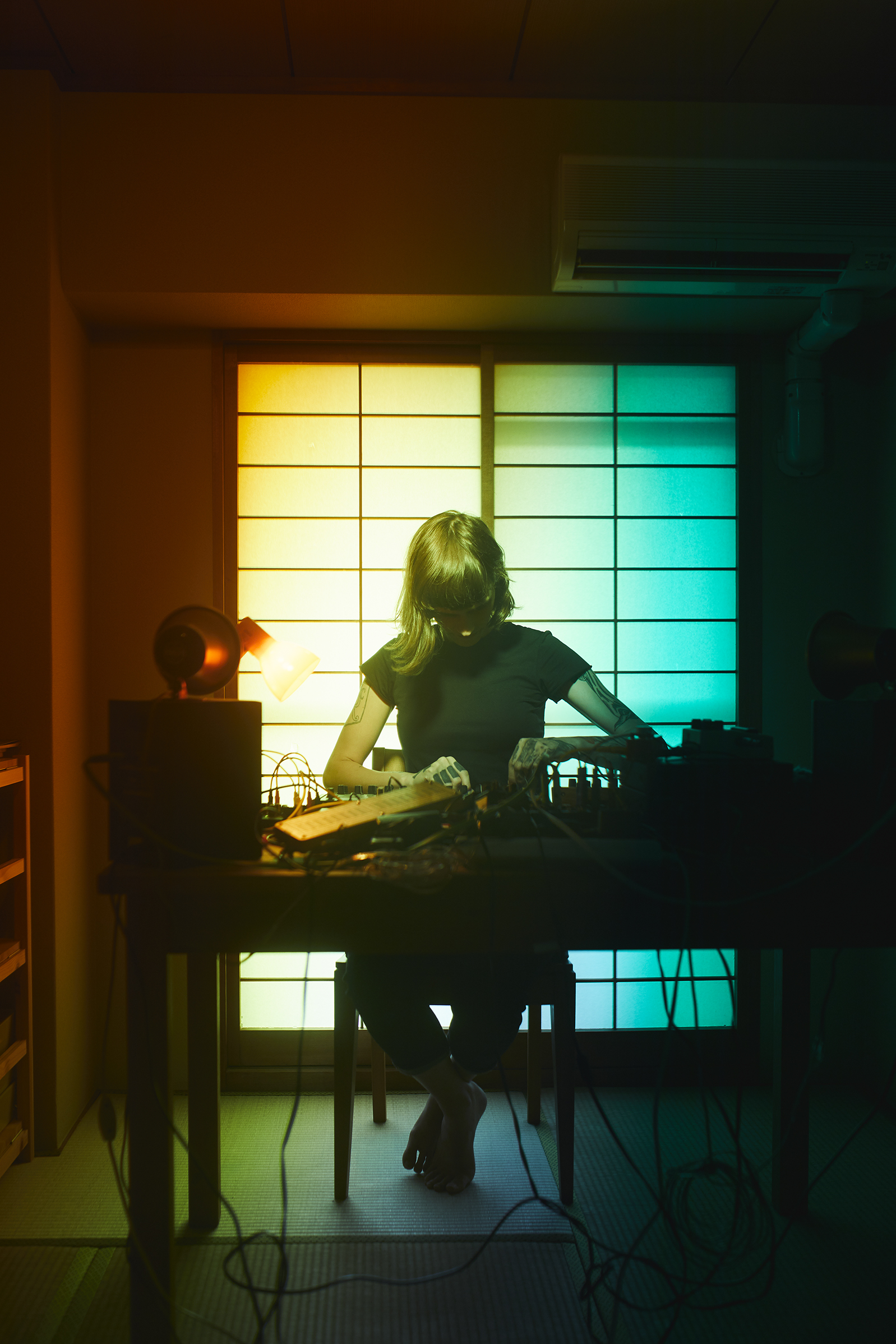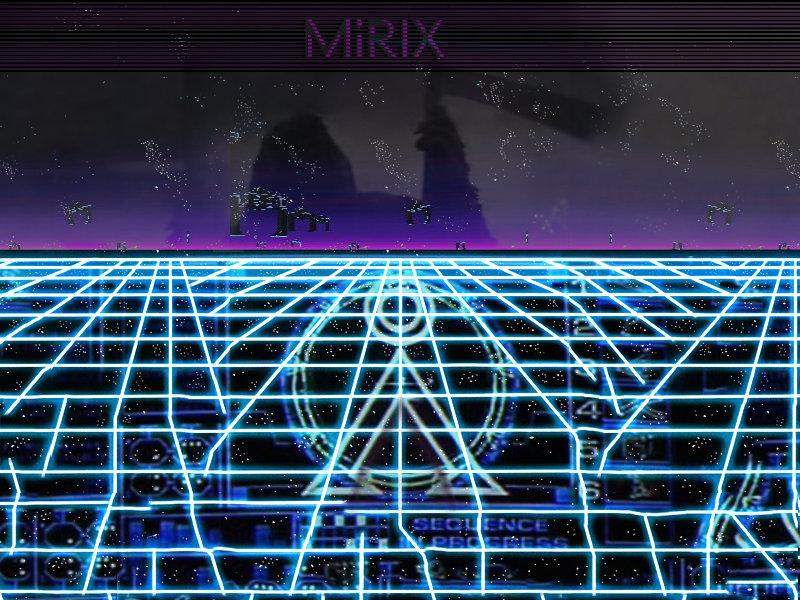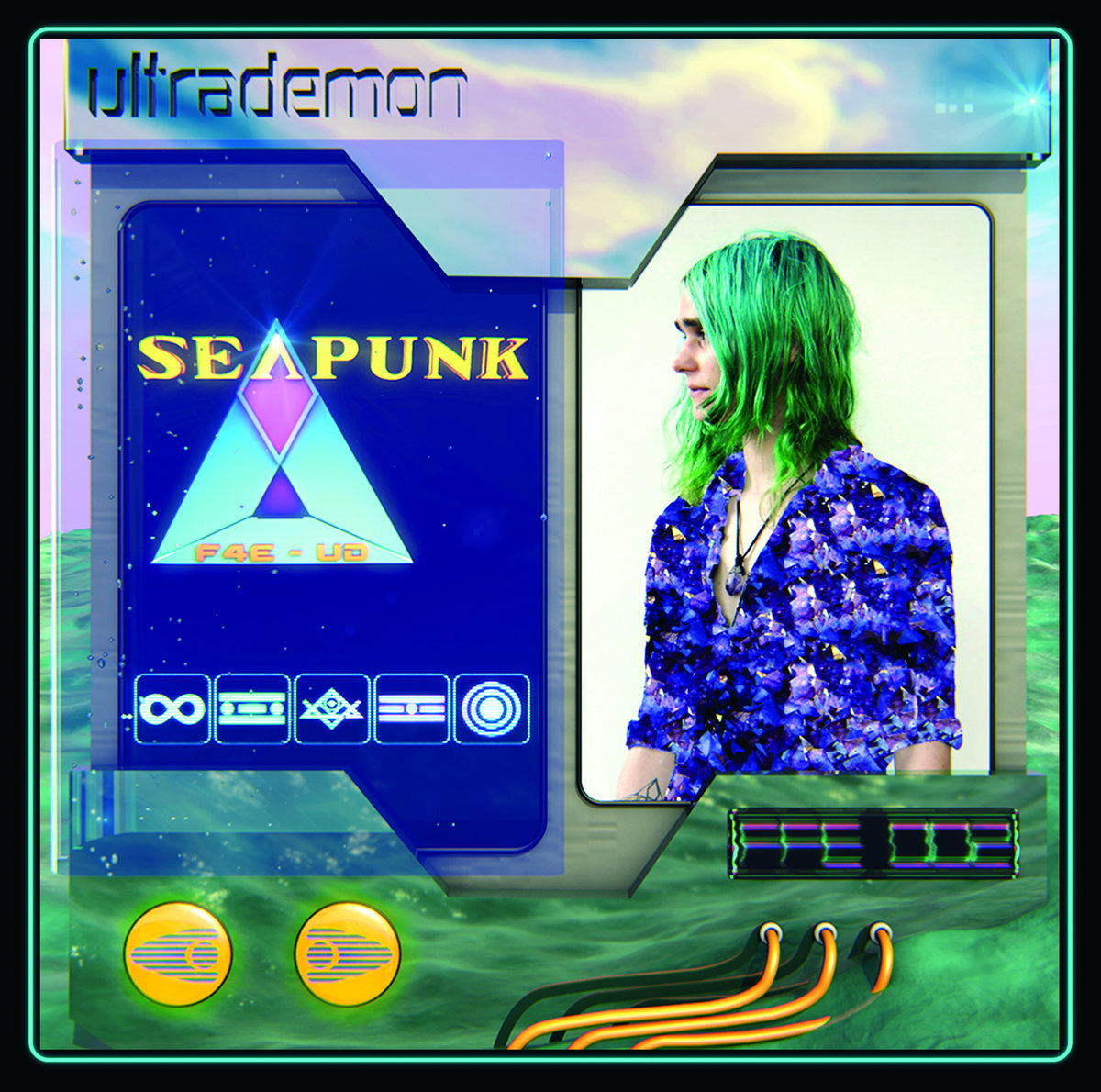The following essay is written by producer Lilium Kobayashi (a.k.a. Ultrademon), with photography by Masuhiro Machida. It’s a deeply personal look at her entire life and career, hinting at the heart of the creative process itself, and what it means to make music in 2019….

Bifurcation of Forms
“…the definition of experimental music is ‘the result of an experiment’.”
Letting the overarching culture define the activity of an artist has little to do with the practice of the art form. Daily experimentation with conventions heard and learned yield an ‘experimental music’. For me, that definition is poetic rather than fixed.
I had a childhood friend I was rather close with, Hank. I hadn’t seen him in perhaps 6 years when he reappeared at my house. I was around 15 years old, maybe right before that moment.
He played for me what he called ‘emo music’.
After we listened through his mix CD, one that stuck in my memory was a piano ballad.
I wanted to try it, to be that full of longing.
I tried writing a song for a girl I liked.
I had a chance to play it for her.
She was uninterested.
Her boyfriend was there too.
He liked it.
He and I made an electronic metalcore band after they broke up; I called it Fire For Effect.
I don’t really write music ‘for’ people after that point.
I start my journal of sonic pains.
Outside my suburbia was field. Many fields.
Farmland or undeveloped sprawl plots.
Endless field.
Kansas Radio
There is a chapter in Gibson’s Mona Lisa Overdrive that spoke to me on a textural level. (I suppose memories are textures.)
The chapter is titled “Texas Radio” and it tells the memory Mona has as she sleeps on a private jet, leaving the town she was stuck in, making her way to what is effectively Los Angeles.
That dream is her making love in a field as a broken radio coming from the nearby scooter parked on the side of the highway plays steel guitar, it’s melody phasing in and out of radio static.
I imagined some automated machines, turned off for the evening near by.
A rural landscape, our near future perhaps. Or just reminding me of a lusher version of sci-fi film canon of my youth.
This Midwestern desire turned inward, we have our own broken radios, playing the only station we could on repeat, phasing in and out, memories of origin.
I couldn’t hover above the ground, my baseline was distorted.
Something I should reckon with.
No matter how far you travel — it will always be there. Along with the memory of desire in youth, or lost chances, regret, shame over those you hurt as you make your escape.

When you change yourself, you always wonder about the other selves. The atemporal ones. When you change yourself beyond what most others can perceive, you can see beyond the scaffolding that holds up their own desire.
Somewhere in that field I left a piece of my heart, I once thought.
Somewhere in my mind the answers were buried.
No answers there. No answers anywhere.
We can’t neglect the part of us we carry from whence we came. It follows. The fields are endless.
Who knows when a storm will come and sweep away the materiality of it all?
At least the static noise phases with the melody, and plays the background of our fleeting desire.
The perception of combined dynamism and silence is not indicative of a universal field; the singularity of your desire can have the backdrop of any number of fields.
Surroundings change. Foliage will vary.

Toy Factory
Noise as defined by culture takes on entirely different meanings.
The booming of bass from a car in Chicago versus the shouting of a politician from a passing car in Japan. Variance being: time of day, frequency ranges, sound system architectures. Thus, noise seemingly is more relative — and it’s cultural definition (at least to my generation) evokes well… that guy with the guitar pedal suitcase doing Merzbow karaoke.
Noise was left to the wayside… or I should say, the variables in the experiment changed.
Some new kind arrives. I play the role of a keyboardist in a band.
I signed my first record contract at 17. (A six album deal, it was the last before the shift at Warner Brothers to all 360 deals.)
Me and the guitarist knew something would happen with the band. Not egoic — kind of in a disarming way.
When that band played San Francisco, I remember one of our vocalists (we had two singers, not in the crust punk style) told me how two young women came up to him after the show asking about ‘that girl on keyboards’.
He thought this was pretty funny, though didn’t tease me much. Maybe due to the closeted gay relationship he terminated months prior, there was a mild understanding embedded under his broken masculinity; at least I hoped he understood something.
Hearing those women felt attractive to me as woman. I felt validated…. I didn’t know why at the time.
Finding the melody trapped within is a reoccurring task, though there are moments of clarity where we channel some other sound. It pours out then. Working within and without different modes and scales we discover the discursive voice. The background noise to our desire becomes its primacy. Melody steps forward; the answer is now music to our ears, for all to hear. An attempt at a universal language perhaps. A wasted attempt — the voice is a singularity. The innate desire to connect isn’t even universal as we try to rate and value creative talent.

Who can hear the voice the clearest?
I left the band, and then after some deep trip I joined the idea of a band.
It was a whole queer performance art group, though really just one man — and his loving followers. A traveling party. Performance art.
The literal-minded Midwestern city drew an ‘in your face’ camp, layered with symbol.
I use the term queer not as it’s used now. At the time it meant something else; at least that’s how I felt it.
A protest — vague and unyielding. Chaotic.
Writing songs for him in the warehouse, tweaking out of my mind.
Dirty, gothic, industrial tunes on repeat, dry skin and eyes.
Always cold for some reason, ignoring the dishes (roommates hated that).
Driving across town for black hair dye at 5 a.m.
Renting a cotton candy machine for the Goth party we would throw.
Other fond memories, some of those who are not with us anymore….
The fallout of the euphoria into a darkness. Foreshadowing.
The sound moved into a post industrial scape.
A tinge of some disco, Crowley, Slyvester, Arthur Russell, Trent Reznor.
My work with melody was open then; I’d completely left the field.
I was in the machine 24/7; the melody poured out of me.
Intentional Artifacting
I’m an archivist.
Cataloguing feelings, modes with traction.
Sound banks of emotion.
A thousand ways, a thousand times.
In that Brooklyn studio the train passed by the the fifth floor window.
His assistant asked me about my hometown.
“Kansas City”; I had no shame about where I was from… at the time.
Of course now it’s come full circle, as Kansas City’s gained some sort of credibility in recent years. (Hilarious considering it’s more or less a Trump think tank.)
“Oh… isn’t that just a flyover town?”, he smirked.
I got somewhat reactive….
He doesn’t know about the secret bastions in the lost warehouses?
The alien plot that worked with the mafia to stack those old parties?
How would he know about the times and places when we would duel?
Summoning circles outside in the middle of winter?
Those of us who gave into the darkness and disintegrated.
Those of us we lost to the hatred and had to push away.
And those parts of ourselves we left and we regret to this day.
How would he know about all the dreams we shared when we were floating together? Shrouded in darkness. Streaming in tears. A single swinging light in that warehouse.
Some truth through melody.
Artifacts in the catacombs of desire.
He wouldn’t know.
Some lost nirvana.
My parents’ hometown was destroyed by a tornado years after they left.

One of the images taken from that Brooklyn shoot became sort of popular in my little world; it was shared around during the seapunk wave.
I was known by it for a moment.
It ended up being on the cover of that Rephlexian record.
A sort of marker.
This new cycle of refrains is a slower modulation. I’ll work to dig out these feelings, and find a self unspoiled by the conceptual frame works of sonic expression.
I saw Heavee at some smokey room full of bass on a cold Chicago night. The north side — some gentrified place far outside of my regular haunts. “I saw that you leveled up.”
Not sure by what metrics… though I felt affirmed.
Club (False Body)
“Sometimes people just don’t get along and mask it with hierarchy, the submissive wants to be the authority, the authoritarian wants to submit, and the rebel isn’t revolutionary, just a confused submissive, that follows.”
The club has been an attempt at the unification of the field and machine.
They give lip service to the depth of self one can encounter in this supposed temporary autonomous zone.
Smoke and mirrors.
I’d prefer the real metal show; at least the flier looks designed. To imitate a thriving underground scene — a modern craft.
The club as imitation.
Sorry I mean, the club is imitation.
Mimicry.
Playing emotional pieces in a club situation can invoke tension from the audience; the song could sound quite sentimental or full of sadness, yet in that setting it invokes a tension that is darker, Perhaps F# Lydian #2 #6 (for the Eurocentric and coordinate dependent of you) mode would invoke. I don’t read music, by the way.
Thus, the audience/performance axis creates new dynamics, reframing perceived notions of ‘playing outside’.
The topology of the sonic milieu becomes the musician’s instrument.
(Intentionally train wrecking, perhaps.)
It only has to suggest through artistic merit and meager semiotic criteria a reference to some Deconstructionism — an illusory shared private space.
Hiding Academic Adjacent
Every city I’ve lived in, it’s always like a magnet. I’m somehow near the academics — perhaps failed artists by someone’s metrics. I don’t really feel that sentiment, yet I know their struggle. I guess it’s similar. My natal chart says I’ll never get appreciated for my work, at least in this lifetime. Again, not sure by what metrics….
Somehow I sneak into the institutions. Not with intention; either it was my subconscious or I am snuck in by an operator — a bad actor maybe? I love entertaining illicit narratives.
I would think a subversive would assist me, though all this is sounding a bit dramatic.
I was attending a multi-institutional conference and one of the talks was on the blind spots of ethnography.
The person speaking was from a Northern European country.
They kept showing their blind spots throughout, unintentionally.
Saying a number of inappropriate things, they didn’t notice their own during the talk.
Something about observing academia from the ‘outside’ permits levity — a critique…. You can see through the facade, the performance of it all. I mean, there’s nothing to lose.
The repressive & obsessive cultures it permits & subsumes.
Though, what is the job of the auditor? Whose law will I encode? As the hands and arms of the academic purview codify their resonant fields, I filter frequencies carelessly added. Subtractive EQ is popular.

Borrowing Schema
What’s the exotic view of the exotic?
In the world of craft it is said that “making is pollution.” For example, here in Kyoto dyed fabrics were washed upstream in the past. As time passed, more toxic materials were used and thus even in the most ‘natural’ of craft there is always a waste byproduct.
As musicians, we don’t see this materially. (One could say electrical use is an example; I give them that.) I do think there is moreso a cultural waste we much deal with.
The toxic waste of our work — what one is responsible with, not just the cancerous examples of on / off switch dynamism online. The voice of the artist within the work. How the modulation of the appropriated flow effects the whole, and the notion of the singular voicing. This differs from sincerity in one’s work, though they could be in parallel.
William Kentridge talks about how artists draw from other’s pain to make works, whereas he tries to empathize and sit with the other’s pain, putting it to the forefront. You can see within his work a sincerity, and the brutality of the other’s pain, not an exploitation — with residual toxic fallout. Personally, I try and draw only from my own.
The well runs deep… or fear of polluting a dying world.
“Mountains should be seen not heard”
—Ursula K. Le Guin (Left Hand of Darkness, p. 244)
So what is the soul of a cultural property?
In the context of sonic appropriation I feel more of an invitation than anywhere else artistically to indulge. Communities openly give their works to each other, to share… sometimes.
I’ve learned no one can truly recreate your sound, an unsound invitation at least.
Cultural properties gain perceived value not only through the definition by a nation or state apparatus, but through the repeated use and tradition of use.
More modern forms emerge; surely we all have our scenes we grew out of, or are drawn back to. Permutations and modulations as the wave is replenished with new blood and fresh eyes.
The idea of that being a property is the illusion. It is a property not by an abstraction, yet by its use.
“This place is occupied, the residence is in use.”
Surely it’s cherished by those that hear it within and without; though it is no ones to hold, it’s resonance reminding those who know its call.
Perhaps this is what makes music so sticky.
We hear each other’s calls; we know each other’s songs.
Each scene is a type of craft.
Craft is like container that moves the soul of that cultural property along.
Craft is a container of a potential spectrum of possibilities.
Craft is now shifted from folk to design. Indeed more indicative of new tools than anything. The voicing of a musical entity is then the container of the craft of its scene.
In my late teen years in Kansas City, I was on the outskirts of the punk scene; my primary influence in a live setting was the hardcore and metalcore of the early 2000s.
Though the live atmosphere of the hardcore and metalcore scenes was an amalgamation of abstinence, Christian puritanical values, and a very real expression of violence, anger, and repression; I can’t speak for the whole city, but at least the suburban variate I frequented.
A language of gothic poetics, embedded in a fusion of styles, the smell of the grass from the fields….
As the sun set,
Some little youth group building,
Adjacent to the mega church,
Kids from each sprawled suburb surrounding the city,
Youth large T-shirts, and the smell of hormonic disharmony,
As a purge of our frustration with the predicament we all faced.
The conditioning we all went through, effectively cult programming.
I don’t want to make any broad generalizations. Claims about group identities so much. Yet,
The sound of our people is in violence.
I feel this at times; maybe violence is just a part of me. Though this thinking is what got us into the whole mess. Recent history has to be sorted out. Work has to be done.
“For me normally, the most important part to create a thing is to sit and stare at something that is nothing and then you have to decide when to break the peaceful canvas. The same goes for music; you have to decide where you want to disturb it and make it into something new.”
—Gaahl (Metal Injection interview, 2019)
Alternating Flows
The location of the mainstream and underground flow is not a mystery. It is based on an incorrect assumption — that they are the only two existing, a binary flow.
There is a multiplicity of streams and flows to locate within sonic topology.
We appropriate these acoustic flows to find each other within ourselves. Perhaps a fear is the gamification of our desire, the desire to enjoy and participate in these cross cultural flows. That psychic energy is used against us within new machines, systems that regulate and reward, unknowingly mostly, to bring out the most polar sweeps between our desires.
The sound becomes alienated from the self — abstracted and lost within maps to nowhere, this topology is void of the flow we hear within.
Within this new landscape, the fear of these theories as a mode for ideology is very real. We question each other constantly as this a-singularity continues to permeate and modulate within every angle of everyone we know.
“Friendly power proves more powerful than repressive power. It manages to not be seen at all.”
—Byung-Chul Han, psycho politics
We lose the memory, the sound we shared. Pop is now even viewed as permissible artistic endeavor as it can be psychically commodified for personal political affect.
Serving the vehicle of the pop music machine pays homage to the archetypal family and gods we recite and obey. Even the illusion of ‘avant pop’ (as if there is a thing) is merely a mirage; no thirst can be quenched in the land of the dead.
Pop music is a mono culture.
Its appeal is that of global populism; it voids cultural definition.
Constant appeals to each sound’s representation on the popular stage is an archetypal ruling class.
It subsumes all.
They appreciate power.
No cellphones allowed in the privacy of thine Diva’s performance.
She convenes with her masters — the spectacle of her concupiscence, imbibing upon toxins. She betrays her sisters.
Sony Music has a new AI music division, investing in research towards generative music. Spotify and Apple Music are essentially the new record label. Yet we see music at the highest profit levels ever, due to multiples perhaps.
Artistic flow requires mere levels of appropriation.
Acoustic flow is static — dynamism occurs later, i.e. “having a voice”.
This modern definition of experimental music is a global refrain.
A relief from the ubiquity of data and modalities of a group’s voice.
Somewhere between the field and machine is the rendezvous point.

Voidic Charms
“It is a common failing of childhood to think that if one makes a hero out of a demon the demon will be satisfied.”
—Yukio Mishima (Confessions of a Mask, p. 72)
This voice inside that sounds like I did in my early-tomid 20s.
All I ever wanted to do is take you all out of where you were, and bring you to the place I am.
It’s not necessarily happy or pleasant. It’s not a Nirvanic temple, no beautiful respite. It’s some new hell.
What depths can we explore together?
In these cavernous voids of self, we carve away little pieces of who and what we think we are.
Nothing is left but a frail semblance of identity.
These voidic charms are fleeting notions of self.
Fleeting notions of identity.

The field is a safety net, a place where desire is free to form itself and realize itself beyond its home. Near by, the broken machine will playback a memory from that home as we plan our escape.
The field is the sonic milieu.
The machine is our local internalized identity, filtered through the panopticon. That is why we receive it embedded within static.
A distorted form of the provincial.
If you read the rest of Mona’s story, it might make sense why I identify with her.
Within the field the form splits and reduces, hidden locations auditing the sound.
The vanity fair of the false sound.
Borrowing the sound from other’s fields.
A plethora of underground waterways and reservoir.
Ultimately the fool’s gold.
The knowledge of the sound is intrinsic.
We learn the language of desire independently from our own voices,
and apply these truths to our sonic perception.
The appropriated flow is only an assist to the internal guidelines we preconceived. Preconceived notions of desire.
Free flowing.
Lilium Kobayashi’s latest Ultrademon LP, ‘Chamber Music’, is now available on the Kyoto-based label Soft Architecture.


